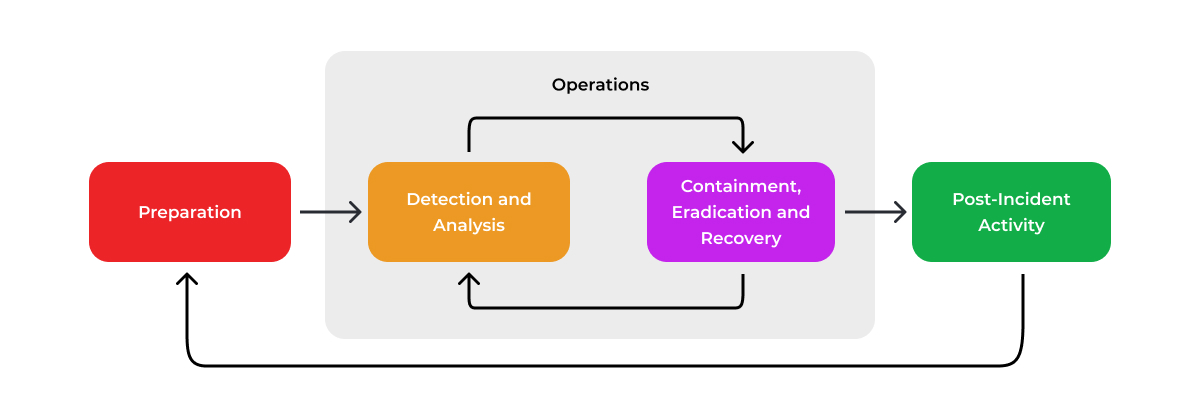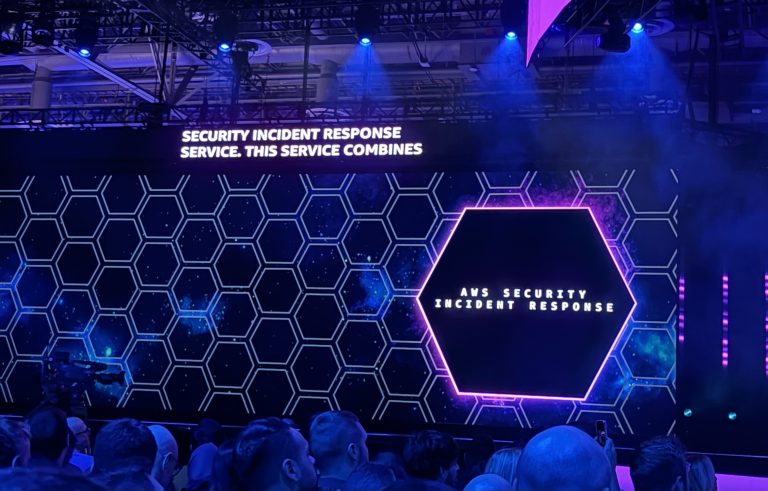According to the Office of the Australian Information Commissioner (OAIC), malicious or criminal attacks were responsible for 67% of all data breaches reported by Australian businesses in the first half of 2024. The financial impact of these breaches is equally concerning. IBM’s 2024 Cost of a Data Breach Report found that the global average data breach cost rose 10% from the previous year. Misconfigured cloud services can increase your organisation’s risk of incurring these costs, reinforcing the necessity of proactive cloud security measures for organisations leveraging AWS.
With these risks in mind, we examine the three foundational pillars of AWS Security Incident Response— Preparation, Operations, and Post-Incident Activity. Each pillar plays a crucial role in helping organisations strengthen their security posture, minimise the impact of cyber threats, and recover quickly.

Overview of AWS Security Incident Response
The AWS shared responsibility model divides security duties between AWS and its customers. While AWS secures the cloud infrastructure, customers must protect their data, applications, and configurations. A well-structured incident response strategy prevents breaches and helps ensure compliance with frameworks like ISO 27001. Preparation strengthens defences, reduces downtime, and enables swift action in the face of unexpected threats.
AWS Security Incident Response is a critical component of the cloud security framework. It focuses on managing and mitigating security incidents in cloud environments. It integrates tools, strategies, and best practices to enable rapid threat detection, thorough analysis, containment, and recovery to minimise disruptions to business operations.
However, cloud environments can present complex challenges, such as alert fatigue due to the vast amount of data and telemetry available. This can lead to team burnout, particularly as incidents rise. AWS Security Incident Response Specialists address these issues by monitoring your cloud environment with tools like Amazon GuardDuty and AWS Security Hub and preparing a response plan for a cybersecurity breach.
Pillar 1: Preparation
Preparation combines teams, tools, and processes, ensuring organisations are fully equipped to respond effectively to security incidents. A comprehensive approach to preparation should include:
Preparation involves aligning your incident response objectives with organisational goals. Key activities include:
- Pre-Provisioned Access: Ensure response teams have the necessary permissions and access to critical systems before an incident occurs.
- Training and Awareness: Conduct regular training sessions and incident response simulations to familiarise teams with their roles and responsibilities.
- Defined Roles and Authority: Clearly identify who to contact in case of an incident and establish what actions each team member is authorised to take.
- Recovery Strategies: Establish clear recovery options, such as Infrastructure-as-Code (IaC), to enable rapid service restoration. If IaC is not in place, organisations must determine alternative recovery strategies.
- Simulation Training: Conduct regular incident response exercises, such as ‘game days,’ to evaluate the readiness of tools, teams, and processes.
- Logging and Forensics: Use game days to identify gaps in logging, ensuring critical forensic data is captured for remediation and investigation.
Pillar 2: Operations
Incident Lifecycle in Operations
The operations phase involves detecting, analysing, containing, eradicating, and recovering from incidents. Key tools include:
- Detection: AWS CloudTrail for real-time monitoring.
- Containment: Automated threat intelligence and enrichment through AWS Lambda integrations.
- Recovery: Rebuilding secure environments using infrastructure as code, such as AWS CloudFormation templates.
Scalable and Automated Approaches
Automation plays a central role in AWS’s incident response strategy. For example, AWS Security Hub integrates findings from GuardDuty to prioritise responses and escalate critical incidents automatically. This scalable approach reduces manual workload and improves efficiency.
Pillar 3: Post-Incident Activity
Key Focus Areas
Post-incident activity involves learning from incidents to enhance future responses. Key activities include:
- Post-Mortem Analysis: Evaluate what went wrong and identify gaps.
- Updating Playbooks: Refine and expand incident detection rules and response playbooks based on lessons learned.
- Compliance Alignment: Ensure responses adhere to regulations such as the ACSC’s Essential Eight Maturity Model.

Measuring Success
Metrics such as Mean Time to Detect (MTTD), Mean Time to Recovery (MTTR) and the number of incidents detected versus mitigated help organisations evaluate the effectiveness of their incident response strategy.\
Conclusion
AWS Security Incident Response is essential for organisations leveraging cloud services. The three pillars—preparation, Operations, and Post-Incident Activity—provide a comprehensive framework to mitigate risks and respond effectively to security challenges. Preparation equips teams with the tools, playbooks, and training necessary to address incidents proactively. Operations ensure real-time threat detection and automated responses, minimising disruptions and enhancing efficiency. Post-incident activities focus on continuous improvement, refining strategies to bolster resilience and meet compliance requirements.
Why Choose RedBear?
RedBear recently gained the AWS Security Incident Response Specialisation and is equipped to help organisations prepare for and respond to security incidents. With deep expertise in cloud security and AWS solutions, we guide enterprises through the complexities of securing their environments.
From preparation to post-incident recovery, our experts equip your organisation with the tools and knowledge to mitigate cyber threats. We leverage our expertise and industry-leading AWS security tools—GuardDuty, Security Hub, and CloudTrail, to name a few —to deliver proactive, scalable security solutions.
Partnering with RedBear means strengthening your cloud security maturity with a team dedicated to resilience, compliance, and continuous improvement. Contact us today to schedule a consultation and leverage our expertise in AWS Security Incident Response.


